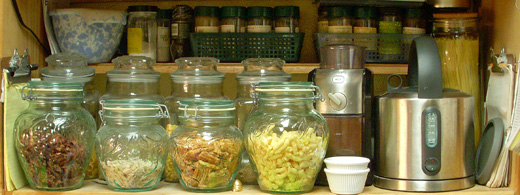Culinarion: Blame It on the Boner

Although I’m trying to work up a page on my trip to Los Angeles last week, here I am talking about food again. The Juice of Eleven Lemons figures slightly in what follows, but only in a supporting role. This entry is really about my Cuisinart.
D’you remember when Cuisinarts were special, and only rich people had them? I still recall Kathleen’s smoldering, furiously, at a hostess who told her that salmon mousse is “no problem” with a food processor. We didn’t have a food processor in 1981. And Kathleen didn’t cook, either. Actually, she cooked more then than she does now, which is not at all.
Yes, I know; Cuisinarts are still expensive. But so are cars and houses. You buy a Cuisinart (just as you buy a KitchenAid stand mixer) because it is an essential kitchen appliance. You expect to last at least as long as the car, if not the house. You buy the Cuisinart because you have grown beyond the American idea that pots and pans are cheap. What will happen when every man, woman, and child possesses an All-Clad sauté pan is hard to imagine, except for the easy part: those sauté pans aren’t going anywhere.
The idea was to make a cool and elegant summer dinner. And I succeeded! (Kathleen will provide testimonials to all stamped, SEE requests.) Recipes will be forthcoming. Without leaving the house, I found that I had the ingredients on hand for Senegalese soup — a cold purée of curried chicken and vegetables that, if you ask me, needs some sexing-up for the Twenty-First Century, but only because it tastes so good. The entrée was Arctic char, which — who knew? — is really a light and rather more expensive form of salmon. You read such terrible things about salmon today that “Arctic” sounds good all by itself — it must be too cold out there in the Bering Sea for all the nasty parasites that hit the farmed fish farther down. To top the cold poached fish, a wonderful sauce from the heretical, 1997, Guarnaschelli edition of The Joy of Cooking. Called “Scandinavian Mustard-Dill Sauce” (page 79), it is a lighter cousin of mayonnaise that lights up the flavor of cold meat or fish instead of smothering it with flavors.* It also looks very good, sleekly coating a filet of (otherwise rather dry-looking) fish. With William Greenberg’s chocolate chip cookies for dessert, this was a dinner to stay home for.
The eruption occurred during the making of the Senegalese.
To make Senegalese soup, you cook aromatic vegetables — onion and celery — in butter and curry, adding flour toward the end as a way of thickening the finished soup. The vegetables get tossed into the food processor along with cooked, diced chicken and a bit of broth. After the death of a million billion cuts, you bring this mixture to a boil, with lots more broth. After chilling the soup, you add a generous dollop of cream to each serving. That is the theory of Senegalese soup.
In practice, it turned out that I’d done a less than thorough job of de-boning a recently roast chicken. I roast chickens all the time. Kathleen and I eat the dark meat, saving the white for salads and other dishes. Recently — all too recently, some might say — I have come to see the wisdom of cutting up the leftover roast chicken after washing up the dishes on which we’ve just eaten the legs and the wings. Better that than to wrap up the carcass and throw it in the fridge — oh don’t, as Lotte Lenya sang, ask why.
Having wilted celery and onion in the saucepan, I tipped the cooked vegetables into the Cuisinart. I dumped in the pieces of cut-up chicken breast and poured in a bit of broth. Then I locked the lid and flipped the toggle switch. The Cuisinart had barely started whirling when there was an Event. The machine survived just fine. In fact, it never stopped whirling. But an impasto of what I can only call vomitrocious soup bits was splattered over the whole range of counter accoutrements, including the new Flippi fan, which has not stopped broadcasting the fragrance of cooked celery since.
Getting all the bits of bone off the Cuisinart blade was lots of fun.
It’s incidents like this that reduce me to incredulous astonishment that my incompetence in the kitchen has never made anyone actually ill. Or — more to the point — choked anybody!
* Here’s where the lemonade comes in: the recipe called for lemon juice and sugar; so I got lazy.
